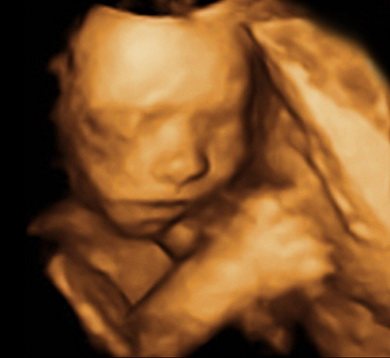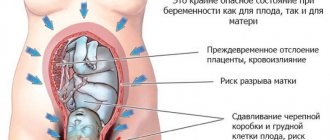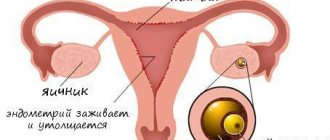Fetal development at 40 weeks of gestation
Now your baby is completely ready for birth, although his nervous system is still developing. The child actively reacts to your emotions. Try to think positively, worry less and get upset over trifles.
Size, weight and height of the baby
The weight of a child at 40 weeks of pregnancy is approximately 3000 grams. Height from head to tail is 37 cm, and full height is about 50 centimeters. As you already know, these are average figures. In fact, everything is very individual.
What's new in child development
Now the baby looks exactly the way it will look when you first meet. Let's look at what happens at 40 weeks of pregnancy:
- The fluff that previously covered the baby’s body is almost completely absent;
- The skin became pink, the palms and heels were slightly wrinkled;
- The original lubricant has practically disappeared. It remains only in the folds and helps the child avoid chafing;
- The size of the fetus at the fortieth week of pregnancy reached its maximum. The uterus occupies the entire abdominal cavity, and the child occupies the entire uterus. Therefore, fetal movements are very limited;
- Fetal development at 40 weeks of gestation is almost complete. In the little person’s body, all systems are being adjusted, the internal organs are preparing to work independently;
- There is meconium (original feces) in the intestines, which will be released a few hours after birth;
- The reproductive system has finally formed;
- The fetus at 40 weeks of gestation is ready to take its first breath, but lung development is still ongoing. Many expectant mothers are interested in the question of whether the baby must cry after birth. The answer is unequivocal - “yes”. The baby's first cry occurs immediately after the first full breath of air and after the opening of the lungs;
- Most babies at this stage are already comfortably positioned head down, preparing for birth. But if your baby is “sitting on her butt” or is in a transverse position, the doctor will most likely plan delivery by cesarean section.
Movement activity before birth
At 40 weeks of pregnancy, the baby is already a little bored in the womb, since he does not have the opportunity to move as much as he wants. It often happens that shortly before birth the baby practically stops his motor activity.
There is no reason to worry, he is simply accumulating strength to overcome his first difficult path. Moreover, the closer the birth is, the calmer your baby will be in his movements.
The importance of ultrasound for a child
An ultrasound scan is prescribed by a specialist at 40 weeks of pregnancy in cases where the results obtained in previous diagnostics gave negative results. The main indicators for additional ultrasound examination are:
- Danger of hypoxia;
- All kinds of umbilical cord pathologies;
- A certain delay in the intrauterine development of the child.
At 40 weeks, the fetus is ready to be born, all the baby’s organs and systems are fully functioning. But doctors cannot provide the expectant mother with a 100% guarantee that everything will be fine with the baby before birth.
A lot depends on the condition of the placenta; with severe aging at the end of pregnancy, the formation of cysts and calcifications inside the organ is observed. This threatens the baby with malnutrition, oxygen starvation and, as a result, his death even at 40 weeks.
To save the child at the end of pregnancy, specialists prescribe delivery, and sometimes perform a caesarean section.
At the end of pregnancy, the baby moves little. This can be seen on an ultrasound, and the mother herself notes this change in the baby’s behavior. He became very large, and there was not enough amniotic fluid to easily perform movements.
When determining the incorrect presentation of the baby, a pregnant woman is recommended to go to the hospital to be under the supervision of specialists. The required number of ultrasounds is determined in this case by the attending physician. When deciding to perform a cesarean section, an ultrasound scan before the operation should be performed.
Ultrasound diagnostics at this time is needed to monitor the baby’s turn and determine the characteristics of the placenta and umbilical cord. The decisions that will be made by doctors during the management of childbirth depend on ultrasound data.
If a pregnant woman had a caesarean section during a previous birth, specialists should use an ultrasound to determine the condition of the suture placed on the uterus. If the suture is thin and begins to diverge, surgery should be performed immediately to avoid possible complications. If the suture is thick, strong, doctors may wait in hopes of allowing the birth to occur naturally.
Condition of the expectant mother at 40 weeks of pregnancy
With the onset of the fortieth week of pregnancy, your body is almost ready for childbirth. Most pregnant women are especially sensitive at this stage because they are waiting for the first symptoms that will indicate that it is time to go to the hospital.
Characteristic symptoms at this stage
Symptoms at 40 weeks of pregnancy:
- The stomach moves down. The drooping of the abdomen immediately becomes visually noticeable to others and noticeable to you (it becomes easier to breathe, heartburn stops bothering you);
- The increase in flexibility of the pelvic ligaments, which occurs at the 40th week of pregnancy, helps to ensure that the baby is not injured while passing through the birth canal;
- Discharge. Doctors recommend carefully monitoring the discharge during this period and if there is brown mucus or blood in it, immediately consult a doctor. It must be said that by the onset of the 40th week of pregnancy, the discharge becomes more abundant;
- The cervix gradually softens, and closer to the birth process it begins to open. This leads to the fact that the plug, which protected the baby from infections, begins to peel off. At this time, discharge with blood is possible. Doctors consider them harbingers of childbirth;
- Haemorrhoids. During this period, the child’s pressure on the pelvis increases, which can lead to inflammation of the hemorrhoids;
- Frequent urination. The pressure of the uterus on the bladder has increased. Don't ignore the urge to pee because it can cause complications;
- Phlebeurysm. Try to spend less time on your feet, but also don’t sit in one position for too long;
- The breast is now ready to feed the baby. Colostrum is often released from it. And on the third day after birth, it will be replaced by breast milk.
What unpleasant sensations may arise
At this stage, all expectant mothers are already thinking only about how to meet their baby as soon as possible, while the feeling of pregnancy does not bring the former ease.
The fortieth obstetric week of pregnancy is one of the last weeks before childbirth.
She is characterized by the following sensations:
- Pain in the lower back and sacral area, which is occurring more and more often. They are associated with an increasing load on the spine;
- Unpleasant pressing sensations in the perineal area;
- Training contractions. Many women are already quite familiar with this phenomenon by the 40th week of pregnancy. Training (false) contractions continue to prepare the uterus for the birth process.
The size and shape of your tummy
At this stage, you are not gaining weight as actively as before. However, this does not affect the size of the abdomen and its shape. At 40 weeks, the belly is not just big, but huge. It turns a pregnant woman into a clumsy teddy bear, so it becomes increasingly difficult to move, it is extremely difficult to get comfortable in bed, and the skin on her stomach is constantly itching.
In addition, as we noted above, the abdomen at this stage begins to sink and harden, which is associated with an increase in the tone of the uterus. This is what baby bumps look like at 40 weeks:

Harbingers of childbirth
The fact that the baby can no longer wait to start moving along the birth canal will be indicated by the harbingers of labor at 40 weeks of pregnancy. Some of them may report the approach of the treasured hour several days in advance - for example, sudden intestinal upset, frequent urge to empty it, and at the same time, frequent urination; change in the psycho-emotional background of the mother with sudden changes in mood. The drooping of the abdomen, which is explained by the lowering of the baby in the uterus and pressing the head against the pelvic floor in order to prepare for childbirth, may be accompanied by painful sensations in the sacrum, spasms in the groin area, and discomfort in the pelvic area. All of these are also harbingers of childbirth, which indicate a high probability of the imminent onset of labor.
The fact that childbirth will occur in almost a few hours is indicated by the rupture of amniotic fluid and the release of the mucous plug. And all this against the backdrop of contractions that are becoming more and more frequent. False contractions can be distinguished from real ones by listening to their intensity and the sensations that accompany them. Thus, prenatal contractions are usually characterized by frequency, greater pain, duration, and do not go away if the woman changes position or begins to move around the room.
The plug has come off
A mother can also be sure that childbirth is “on the threshold” if the plug comes out at 40 weeks of pregnancy. The mucus plug, which until recently covered the cervix and protected the baby from unwanted infections and external influences, comes out in the form of either numerous mucous pinkish or bloody discharge, or in the form of one large lump of mucus, slightly stained with blood. After the plug comes out at 40 weeks of pregnancy, labor can begin in a matter of hours, so the woman needs to be prepared for the onset of contractions and get ready to be sent to the maternity hospital at any time.
40 week pregnancy video
40 week pregnancy photo
Weight at 40 weeks of pregnancy
Some weight loss will also indicate an imminent birth. Normally, by the end of pregnancy, a woman can gain up to 15-16 kilograms “on top” of her initial weight. But, interestingly, the weight at 40 weeks of pregnancy may be less or remain within the same week, for example, 38. By the way, weight loss, sometimes even significant - from 0.5 to 2 kg - occurs due to the removal of excess fluid from the body. So, if during pregnancy the hormone progesterone occupies a predominant position in the pregnant woman’s body, which promotes fluid retention in the body, then from the 38th week estrogens actively begin to accumulate, and they already remove fluid from the body.
Stomach
But weight loss, as one of the precursors of childbirth, does not at all affect the size of the mother’s belly. So, the belly at 40 weeks of pregnancy is not just big - its huge size prevents a woman from walking, makes her clumsy and clumsy, overweight. When going to bed, mom has a hard time finding a comfortable place to sleep, which worsens the situation and the feeling that her stomach itches. Special moisturizing creams for pregnant women against stretch marks still help to somewhat correct the situation, which should still be used regularly.
Necessary medical examinations and ultrasound
In the last days and weeks of pregnancy, you will have to visit your gynecologist quite often. Get ready to travel to the antenatal clinic 2-3 times a week . At the appointment, the doctor will perform the manipulations that are already familiar to you:
- blood pressure measurement;
- abdominal girth measurements;
- visual examination of the extremities for the presence of edema;
- listening to the baby's heartbeat.
An ultrasound scan at the fortieth week of pregnancy is performed to study the following basic parameters:
Want something interesting?
- Child's weight;
- The condition of the baby and its position in the womb;
- Presence of umbilical cord entanglement;
- Length and structure of the cervix. During the entire period of pregnancy, the cervix is not in one state; closer to childbirth, it shortens. The pharynx should be closed or slightly open by 1 cm. During childbirth, the pharynx opens by 10 cm;
- Presence of uterine tone. At this stage, training contractions are considered the norm, but if such contractions occur not only during an ultrasound and the condition worsens, the question of uterine hypertonicity is raised;
- Condition of the placenta. In the final stages, it is very important to determine the condition of the placenta, since its functioning is directly related to how your unborn child eats and breathes. Often during this period, the placenta is already in a worn-out state and does not work fully, resulting in fetal hypoxia (lack of oxygen and nutrients). Over time, the placenta ages and its walls become thin. Now it is easier for infections to penetrate through them. It is for this reason that a pregnant woman in the last stages of pregnancy should visit the doctor periodically, as well as take the necessary tests and do ultrasound examinations as prescribed. If there is any doubt about the functional abilities of the placenta, it is necessary to conduct a CTG study with Doppler;
- Location of the placenta. An important factor influencing the decision on the method of delivery is the location of the placenta relative to the fundus of the uterus. If there is less than 5 cm from its lower edge to the pharynx, a cesarean section is recommended;
- The amount of amniotic fluid and its structure. If there are deviations in the amount of amniotic fluid, conclusions can be made regarding oligohydramnios or polyhydramnios. In the early stages of pregnancy, such a conclusion may indicate the development of an infectious process, but at the end of the third trimester, oligohydramnios most likely indicates post-maturity. But polyhydramnios can be both a variant of the norm and evidence of abnormalities in fetal development.

How to determine the onset of labor
According to doctors' observations, labor most often begins between the 39th and 40th weeks of pregnancy. It is necessary to prepare in advance for the start of the birth process.
Most pregnant women feel the warning signs of labor, which include:
- Contractions;
- The release of the mucus plug that closed the entrance to the uterus;
- Downward displacement of the abdomen;
- Weight loss of more than 1 kg;
- Decreased fetal motor activity;
- Diarrhea, lack of appetite, feeling of nausea.
However, it often happens that a woman does not observe any warning signs.
In fact, labor can begin completely calmly without them. The onset of labor can be triggered by any physical activity, sexual intercourse, or even problems with the intestines.
The onset of labor at 40 weeks of pregnancy is accompanied by:
- The appearance of regular uterine contractions, the interval between which decreases. If the uterus contracts after a strictly defined time, congratulations, the birth process has begun! In addition, unlike false contractions, real contractions are more painful. Most women say that the pain during contractions is very similar to menstrual pain. If you have previously had painful periods, then you can roughly imagine what to expect soon;
- Discharge of amniotic fluid. The outpouring can occur immediately, completely, up to 1 glass, or drop by drop. The liquid can be either transparent or cloudy with a greenish tint (this indicates the presence of deviations from the norm).
Baby and his condition
The baby is already large (weight about 3400 g, height 52 cm). He, of course, felt cramped, this problem will soon be resolved.
By this time, the child’s intestines are filled with fluff and dead cells. Sometimes its emptying occurs inside the mother's womb. This process does not pose any danger; the only thing that is noted is the coloration of the amniotic fluid in a greenish color.
The baby took his proper head position (95%). According to statistics, 4% of women gave birth by 40 weeks of pregnancy. If labor has begun right now, there is no need to panic, the baby is already prepared for this.
Childbirth includes 3 stages:
- Dilatation of the uterus, accompanied by contractions;
- Performing fetal rejection during pushing;
- The result is the birth of a child.
Children born at 40 weeks are full-term, with developed systems and organs. Their weight is about 3500 g, height is 54 cm. There are deviations from the norm, both in one direction and the other. Each baby is individual, its development depends on the genetic information of the parents.
The birth of the first child can take about 18 hours, the second child usually arrives much faster (up to 11 hours). When pushing, help and support from an obstetrician is important.
Possible complications in the fortieth week
At this stage of pregnancy, you should be attentive to the movements of the fetus, which has already become quite cramped in the uterus. Possible complications also include:
- Swelling. Many pregnant women suffer from edema. The fact is that due to the increased load, the kidneys work in emergency mode and may not be able to cope with the volume of fluid entering the body. Feet and fingers often swell;
- Preeclampsia. If high blood pressure is added to the swelling, you should immediately consult a doctor. Such symptoms may indicate the development of gestosis;
- Fetal hypoxia. By this time, the placenta has practically used up its resources, but it is a source of nutrition and oxygen for the baby. It is necessary to monitor her condition using ultrasound;
- Post-maturity. Normally, childbirth should occur before 42 weeks, but there are cases when the PDR is placed incorrectly. A child born after this period is considered overripe. If the pregnancy is too late, a caesarean section is indicated.
Useful recommendations for expectant mothers
The period of 40 obstetric weeks is the time to finish preparing for the meeting with the baby. Helpful tips for this week:
- Take advantage of the last days of your happy pregnancy, spend time with pleasure, relax and walk in the fresh air;
- Double-check your emergency bag. It must contain all the necessary documents, as well as things for you and the baby that will be needed during your stay in the maternity hospital;
- If possible, do not go far from home. Wherever you go, be sure to take an exchange card and cell phone with you;
- If you feel well, you can do light exercises, and walking can naturally regulate the onset of labor.
We recommend reading:











